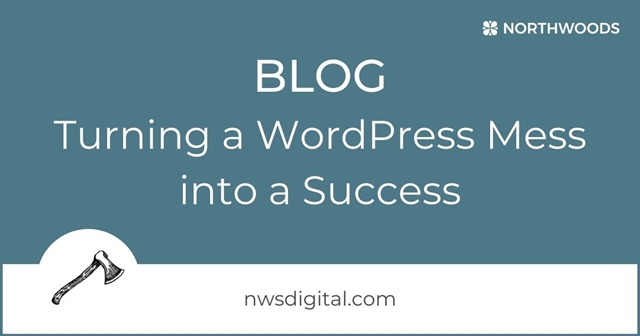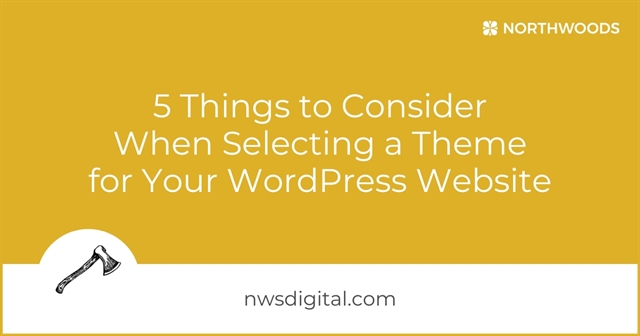By Matthew Karge
November 10, 2020
7 Minute Read
Launching a WordPress website requires a meticulous approach in order to be successful. A team or individual must consider many aspects of the project from multiple points of view – as a developer, a user, and even a search engine. For some, taking on the task of launching a new site is exciting. For others, it’s just plain daunting.
For those who fall into the latter category (and even if you’re more excited than overwhelmed), help is here! We’ve got a website launch checklist that will walk you through what you need to know.
But why should you rely on Northwoods for advice? Our team has launched thousands of websites during the past 20+ years, and that experience has yielded many insights. As a learning organization, we’re dedicated to sharing our insights and expertise, and we’re happy to pass along what we’ve learned to help ensure your project is a success.
WordPress Launch Checklist
At Northwoods, we assemble a team of individuals with specific, complementary skillsets needed for a successful site launch. Our account directors manage these teams; the checklist keeps them on top of the timeline and status for each of the many tasks involved.
We have teams. You probably don’t. So you need the checklist even more than we do.
Your WordPress Launch Checklist will help you focus on completing every last one of the tasks required for a successful launch and will help you carry them out in the most efficient order.
We’re giving you the basic checklist. Note that it is NOT one-size-fits-all; more like one-size-fits-most. Think of it as a customizable inspiration.
WordPress Updates
WordPress, along with the rest of the digital world, constantly evolves. Before you think about the launch, be sure that you have installed the latest version. Some updates may affect how your website performs. Be sure to run the following updates prior to launch:
- WordPress Core
- The WordPress Core is the dashboard, where you login and manage your website. Automattic, the core developer, updates this technology monthly, basis for security and scalability.
- Run the updater to confirm that you have the latest version of the WordPress Core.
- Theme
- You choose a theme to govern the design of your website. The theme technology creates the look, feel, and user experience on your website.
- Before running your theme update, review its compatibility with the version of WordPress Core running on your site. If your theme is compatible, run the update and then test your website. If it is not compatible, you will have to determine the best next steps for your theme.
- Plugins
- Developers from around the world create and manage WordPress plugins, which add functionality to your website. Some developers stick with their creations and update them consistently. Some are inconsistent. Some abandon their products.
- Before running any plugin updates, review each for compatibility with the version of WordPress you have. If it is compatible, run the update and test your website. If not, wait or find a similar, but compatible, plugin.
- PHP
- WordPress and its technologies use the PHP scripting language. PHP is infrequently updated. Still, make sure that you are using the latest version.
Content
“Content is where I expect much of the real money will be made on the internet” - Bill Gates
Without good content, both users and search engines do not know what your website is about. Think about it: Without content your website is literally about nothing. Get content right, and get it right from the very start of your website project.
When preparing to launch, focus on the following content points:
- Proofread
- Correct grammar and spelling errors. Double-check. Check again.
- Format Content
- Layout matters. Make sure the content on your site is easy to scan. Use paragraph styles as provided in your theme and be sure to adhere to a proper hierarchy of headings.
- Check Videos and Audio Files
- Check the files to make sure they work properly and display in the right spot. Broken media is all too common and easily avoided.
- Examine Page Links
- Double-check for broken links. No one likes 404 messages.
- Check downloadable files
- Proofread all downloadable files and make sure they are linked correctly. And make sure that they can actually download.
- Set-Up Redirects
- Are you replacing an old site? Be sure that you have set up redirects and set them up properly.
- Prepare launch content
- Don’t allow your tree to fall unheard in the forest. Prepare social media content before you launch and coordinate postings with your launch.
Design
“If you think good design is expensive, you should look at the cost of bad design” - Ralf Speth
Good design makes for optimal content display across the whole range of user devices. It takes work to make this happen, but the work is worthwhile. Yes, we have a design checklist:
- Verify HTML or Schema Markup
- To prevent incompatibilities, check all pages of your site for adherence to web standards. Adding HTML or Schema Markup improves the way your page is displayed in the search engine results page by enhancing the queries.
- Preview Site in Major Browsers
- Check your site in Firefox, Chrome, Safari, and Microsoft Edge. Your site should display well on all of them.
- Check Your Website on Mobile Devices
- Mobile devices bring in a lot of traffic, sometimes more than desktops. Test your design on different phones and tablets and on various operating systems, such as IOS and Android.
- Optimize Images
- Reduce image size to reduce page load time and thus improve user experience and enhance SEO (Search Engine Optimization). Google has used load speed as a ranking factor since 2010.
- Validate Your Code
- Double-check your styles to detect any problems or errors in your code, such as missing quotes around attributes or missing closing tags. This will avoid formatting and readability problems.
Functionality
“Form follows function - that has been misunderstood. Form and function should be one.” - Frank Lloyd Wright
The most brilliant design and content will not make up for your site’s poor performance. All functional parts of the website must work properly; this is crucial for conversions and overall SEO. Before launch, check these boxes:
- Test Web Forms
- Make sure that contact forms, survey forms, order forms, etc., work properly. Make sure that form emails arrive in the right place, not in junk or spam email folders.
- Check Auto Responses
- Make sure that auto-response emails work correctly and efficiently and do not land in spam or trash folders.
- Check Page Speeds
- Check how quickly your site loads and think about ways to speed it up. Google uses page speed as a ranking factor, so make sure your website’s page speed is optimal to improve your site’s performance.
- Check Social Media Functionality
- Ensure that your social sharing works properly on your site and with the right platforms and profiles.
- Test Any Third-Party Tools
- If you are using third-party tools for ecommerce, marketing, etc., double-check that they work properly.
SEO
“Crawling is not a guarantee you’re indexed” - Rand Fishkin
Your website must be both visible to and understood by search engines for your site to be indexed. Here’s how to make it visible:
- Install an SEO Plugin
- WordPress is already great for SEO, but SEO plugins make optimization easier.
- Optimize Your Page Titles and Meta Descriptions
- Make sure your page titles and meta descriptions are optimized for SEO performance. Include your focus keywords, maintain relevance, and have the right number of characters. Meta descriptions should be unique to each post and page.
- Optimize Your Website’s Images... Again
- Check your image file names, descriptions, and ALT tags for keyword inclusion and user experience best practice.
- Set Focus Keywords
- If you use an SEO plugin, focus keywords help the plugin evaluate the page. This includes the title, H1 tag, body copy, and other elements important to website performance. Setting focus keywords will give you important information on how to further optimize your content.
- Create a Sitemap
- Create a sitemap and share it with search engines. This tips the search engines as to which pages and fields are most important to you. Sitemap metadata tells bots how pages are organized and related to one other. Sitemaps show search engines the overall structure of your website.
- Create Metadata
- Check all metatags for social and RSS feeds. Make sure they are set up correctly and appropriately. Proofread all metadata. Include optional tags, such as rel=”nofollow”.
Launching a WordPress Site is a Complex Task
These checklists provide just a high-level breakdown of the many parts of a successful launch. Don’t skip steps; the parts mesh and build one on the next.
A WordPress launch can be daunting. We’re here to help. Visit our WordPress solutions page or contact us today.
Related Blog Posts

Many organizations find themselves in an unexpected and challenging situation soon after launching a new WordPress website: their beautiful new site has turned into an unruly, seemingly untamable beast. While WordPress is a fantastic tool for creating and launching websites quickly and cost efficiently, constant updates and maintenance are required.

Many WordPress website owners take advantage of page builder tools, such as Beaver Builder and Divi, to build and manage their websites. Whether you’re a B2C or B2B company, your website might have a lot of product data, locations or events. Managing and maintaining large amounts of data with a page builder isn’t hard, but it does take time and a deep understanding of your data. Here are some tips on how to get your data ready for the web.

A theme is responsible for the layout, templates, styles, and other design elements of your website. Here are the five key things to consider when selecting a WordPress theme.